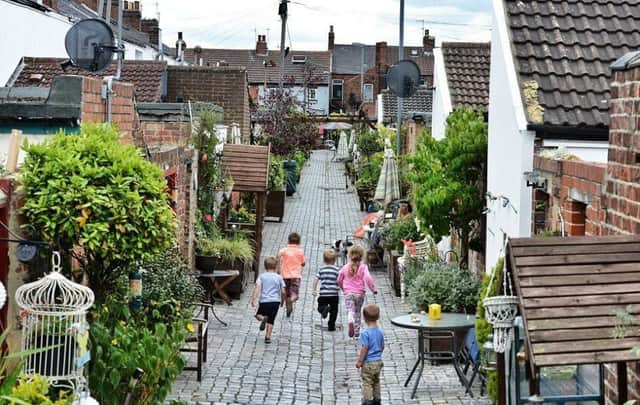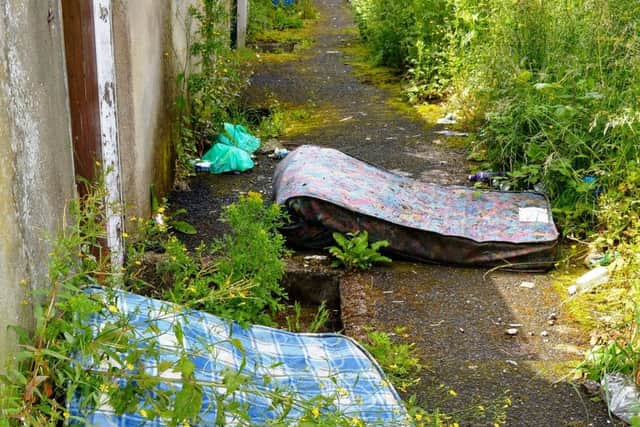Transforming Derry's shabby laneways into '˜pocket paradises'.


Terraced houses are a prominent feature of Derry’s townscape.
Many were built over a century ago - in places like Rosemount, Bonds Street and Strand Road - in neat rows that back onto communal laneways.
Advertisement
Hide AdAdvertisement
Hide AdThese laneways came in all shapes and sizes - some barely the width of two people, others big enough for a car to navigate and a few leading to much larger spaces. They were designed as arteries for the essentials of urban living at that time - especially for bins and coal - whilst also, incidentally, providing a playground for local children.


Life in terraced neighbourhoods has changed greatly in the years since. Regular visits from the coalman have been replaced by the occasional oil lorry or, even, piped-in gas. The need to minimise the amount of modern waste that goes to landfill has seen the old-fashioned single bin replaced by a whole range of bigger ones.
Even the type of people living in terraced neighbourhoods has changed - with rental properties, student homes and young first-time buyers creating a more transient population in what were once established family areas. In the midst of this change, the laneways at the rear of terraced houses have largely lost their purpose. Many have become weed strewn havens for rubbish and dog-fouling, regularly complained about by residents and councillors in the pages of this paper. Clean-ups are organised, often at the expense of ratepayers, only for the spaces to become blighted again over time. Gates have been used in some areas as an attempted solution to things like fly-tipping but have met with mixed success as the very nature of these unloved spaces makes them prone to anti-social behaviour. It is clear that, for many of Derry’s laneways, the status quo isn’t working and they continue to have a detrimental impact on their neighbourhoods.
At the core of the problem is the ownership of these laneways - stuck in legal limbo as neither public nor private space. Residents obviously take an interest in the lanes, given how close they are to their homes, and are the ones who are impacted most when they become blighted. This has led some individuals and community groups to do sterling work looking after certain sections of laneway. But many other residents feel a disconnect towards the spaces as they are not their’s to use or maintain.
Advertisement
Hide AdAdvertisement
Hide AdNeither are the lanes publicly-owned - so, as unadopted spaces, they are outside the responsibility of Council or Roads Services. They are, therefore, ignored and neglected spaces which offer little genuine benefit to anyone.


It doesn’t have to be this way, however. Many of Derry’s terraced laneways are spaces crying out for a new, more positive community role; one that directly benefits local residents who will, in-turn, be more incentivised to embrace and cherish them. In short, we need to completely change people’s relationship with the laneways by finding a new purpose for them.
Cities are busy, dynamic spaces where bits can often get left behind as urban life changes around them. The good news is that any urban space - no matter how small, neglected or seemingly pointless - can be reimagined and given a new, more constructive purpose for local benefit. It’s something I do regularly in my role as a regeneration consultant in England. That has enabled me to discover new ideas for forgotten spaces from around the world and also to help create and implement a few of my own, too. So, when I look at Derry’s unloved laneways, instead of a problem, I see huge potential waiting to be unleashed. The potential to use those spaces positively to change and improve their neighbourhoods.
There are a variety of ways in which this could be done. One example could be to turn the lanes into mini urban allotments. Terraced houses usually have small rear yards - often dominated by an oil tank - but no garden space. So, some laneways may lend themselves to being used by residents to grow vegetables and fruit. The larger spaces would be most suited to this - such as the triangle of neglected land behind Argyle Street - but even small laneways could accommodate raised beds along one side (and still leave space for passing bins).
Advertisement
Hide AdAdvertisement
Hide AdPeople in urban areas, and particularly children, are increasingly disconnected from where food comes from. Giving those who were interested the chance to grow their own would help to address that.
Or, how about a social enterprise adopting multiple lanes around the city to use as food growing space in return for keeping the areas well maintained ? Alternatively, if not food growing, the laneways could, instead, be adorned with plants that would add vibrancy and colour to what are often drab areas, with the residents encouraged to adopt them.
If colour’s your thing, another idea could be to use the laneways as spaces for art. I recently established a ‘gallery’ for good quality street art in a neglected laneway in south London where fly-tipping and drug taking had become concerns. A number of the residents and businesses that backed onto the lane volunteered their walls to be included in the project and a collective of street artists from across London curate the walls and paint fantastic art on them - with the installations changing every three or four months (check out ‘Love Lane’ on Twitter, Instagram or Facebook). The initiative completely changed the look and feel of the laneway and has made it a destination for street art fans to visit and photograph.
Derry’s neglected lanes could, likewise, be turned from alleyways into artways - utilised as canvasses and galleries for good quality local and external street artists to exhibit their work. Artists from overseas are interested in visiting cities if they know that space is available for them to paint on and their work will be appreciated and respected. Using the lanes in this way could even become a catalyst for the establishment of an annual street art festival in Derry, similar to the ‘Waterford Walls’ one. As street art is a huge draw for visitors and urbanists alike, an arts trail of the laneways included in this initiative could itself become a tourist attraction for the city.
Advertisement
Hide AdAdvertisement
Hide AdIf not art, then how about using the laneways to bring neighbourhood history to life? For years, the district of Rosemount adjacent to Magee College was known as the ‘Scotch Quarter’ after the large number of Scottish-born shipyard workers who settled there. An appropriate section of laneway there could be turned into a de-facto open air heritage display - with artworks or installations to help document and explain the history of that part of the city. Or, if not history, perhaps the larger laneways could be closed off for vehicles and turned into mini neighbourhood ‘parklets’ or places for children to play instead.
More than a century after they were first created, many of Derry’s laneways have failed to keep pace with modern living. It should no longer be deemed acceptable to just leave them as neglected, unloved and problematic spaces - and nor should endlessly repeating expensive clean-ups which don’t solve the underlying problem. With a bit of imagination, funding and community involvement, Derry’s laneways could instead be transformed from problem areas into pocket paradises and given uses that are more in keeping with the changed circumstances of 21st century living.
* Steve Bradley is a commentator and urban regeneration consultant from Derry.